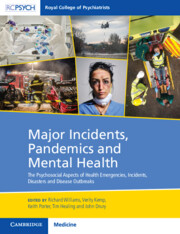 Major Incidents, Pandemics and Mental Health
Major Incidents, Pandemics and Mental Health Book contents
- Major Incidents, Pandemics and Mental Health
- Major Incidents, Pandemics and Mental Health
- Copyright page
- Dedication
- Contents
- Figures
- Tables
- Boxes
- Contributors
- Foreword by Dr Adrian James
- Foreword by Professor David Lockey
- Section 1 The Nature and Impacts of Twenty-First-Century Healthcare Emergencies
- Section 2 Clinical Aspects of Traumatic Injuries, Epidemics, and Pandemics
- Section 3 The Role of the Public in Emergencies: Survivors, Bystanders, and Volunteers
- Section 4 Responses to Meet the Mental Health Needs of People Affected by Emergencies, Major Incidents, and Pandemics
- Chapter 27 Principles for Intervening with the Wellbeing, Psychosocial, and Mental Health Needs of Mass Casualties
- Chapter 28 Facilitating Psychosocial Care for the Public After Major Incidents and During Pandemics
- Chapter 29 Mental Healthcare Required by People Who Are Affected by Major Incidents and Pandemics: Lessons from Research
- Chapter 30 Responding to the Needs of Children, Young People, and Their Families During the COVID-19 Pandemic
- Chapter 31 Social and Educational Impacts of Epidemics and Pandemics
- Chapter 32 Quarantine, Lockdown, and Isolation in the COVID-19 Pandemic
- Chapter 33 Reflections on Managing Infectious Diseases in Mental Health Units
- Chapter 34 Case Study 1: The Omagh Bomb, the Mental Health Response, and the Lessons Learned
- Chapter 35 Case Study 2: A Public Health Survey of People Exposed to the Paris Terror Attacks in November 2015 and Their Consequences
- Chapter 36 Case Study 3: Practical Approaches to Delivering Psychosocial and Mental Healthcare for the Public in the UK: Lessons Learned from a Major Incident in Manchester
- Section 5 Sustaining and Caring for Staff During Emergencies
- Section 6 Designing, Leading, and Managing Responses to Emergencies and Pandemics
- Section 7 Key Lessons for the Way Forward
- A Glossary of Selected Key Terms Used in This Book
- Index
- References
Chapter 32 - Quarantine, Lockdown, and Isolation in the COVID-19 Pandemic
from Section 4 - Responses to Meet the Mental Health Needs of People Affected by Emergencies, Major Incidents, and Pandemics
Published online by Cambridge University Press: 11 January 2024
- Major Incidents, Pandemics and Mental Health
- Major Incidents, Pandemics and Mental Health
- Copyright page
- Dedication
- Contents
- Figures
- Tables
- Boxes
- Contributors
- Foreword by Dr Adrian James
- Foreword by Professor David Lockey
- Section 1 The Nature and Impacts of Twenty-First-Century Healthcare Emergencies
- Section 2 Clinical Aspects of Traumatic Injuries, Epidemics, and Pandemics
- Section 3 The Role of the Public in Emergencies: Survivors, Bystanders, and Volunteers
- Section 4 Responses to Meet the Mental Health Needs of People Affected by Emergencies, Major Incidents, and Pandemics
- Chapter 27 Principles for Intervening with the Wellbeing, Psychosocial, and Mental Health Needs of Mass Casualties
- Chapter 28 Facilitating Psychosocial Care for the Public After Major Incidents and During Pandemics
- Chapter 29 Mental Healthcare Required by People Who Are Affected by Major Incidents and Pandemics: Lessons from Research
- Chapter 30 Responding to the Needs of Children, Young People, and Their Families During the COVID-19 Pandemic
- Chapter 31 Social and Educational Impacts of Epidemics and Pandemics
- Chapter 32 Quarantine, Lockdown, and Isolation in the COVID-19 Pandemic
- Chapter 33 Reflections on Managing Infectious Diseases in Mental Health Units
- Chapter 34 Case Study 1: The Omagh Bomb, the Mental Health Response, and the Lessons Learned
- Chapter 35 Case Study 2: A Public Health Survey of People Exposed to the Paris Terror Attacks in November 2015 and Their Consequences
- Chapter 36 Case Study 3: Practical Approaches to Delivering Psychosocial and Mental Healthcare for the Public in the UK: Lessons Learned from a Major Incident in Manchester
- Section 5 Sustaining and Caring for Staff During Emergencies
- Section 6 Designing, Leading, and Managing Responses to Emergencies and Pandemics
- Section 7 Key Lessons for the Way Forward
- A Glossary of Selected Key Terms Used in This Book
- Index
- References
Summary
This chapter considers the potential psychological impact of the quarantines, lockdowns, and isolation that have affected almost every country in the world as a result of the SARS-CoV-2 (COVID-19) outbreak. It describes the published literature on the short-term and long-term psychological impact of other (pre-2020) pandemic-related quarantines, identifies factors associated with this psychological impact pre-quarantine, during quarantine, and in the long term, discusses how this applies to the COVID-19 pandemic, and suggests how the psychological impact of quarantine and isolation might be reduced.
- Type
- Chapter
- Information
- Major Incidents, Pandemics and Mental HealthThe Psychosocial Aspects of Health Emergencies, Incidents, Disasters and Disease Outbreaks, pp. 241 - 246Publisher: Cambridge University PressPrint publication year: 2024
